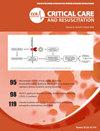Continuous frusemide infusion versus intermittent bolus therapy in paediatric intensive care: A single centre retrospective study
IF 1.4
4区 医学
Q3 CRITICAL CARE MEDICINE
引用次数: 0
Abstract
Objective
Frusemide is a common diuretic administered to critically ill children intravenously, by either continuous infusion (CI) or intermittent bolus (IB). We aim to describe the characteristics of children who receive intravenous frusemide, patterns of use, and incidence of acute kidney injury (AKI), and to investigate factors associated with commencing CI.
Design
Retrospective observational study.
Setting
Paediatric intensive care unit (PICU), the Royal Children’s Hospital Melbourne.
Participants
Children who received intravenous frusemide during PICU admission lasting ≥24 h between 2017 and 2022.
Main outcome measures
The primary outcome was the daily dose of frusemide. Secondary outcomes included timing of therapy from PICU admission, fluid balance at frusemide initiation, additional diuretic therapy, and the incidence of AKI at admission and frusemide initiation. Children who received CI were compared with those who received IB only using multivariable logistic regression analyses.
Results
Nine thousand three ninety-four children were admitted during the study period. A total of 1387 children (15 %) received intravenous frusemide, including 220 children (16 %) by CI. The CI group were younger (132 vs 202 days, p = 0.01), had higher PIM-3 scores (2.2 vs 1.5, p-value <0.001), more congenital heart disease (CHD) (72.3 % vs 60.6 %, p <0.01), and higher incidence and severity of AKI at frusemide initiation than the IB group (65.7 % vs 40.1 %, p-value <0.001). CI were commenced later than IB (46 vs 19 h into admission, p <0.001) and at higher doses (4.3 vs 1.5 mg/kg/day, p-value <0.001). In multivariable analyses, CHD (aOR 1.67, 95 % CI 1.16-2.40, p <0.01) was associated with CI.
Conclusion
Frusemide infusions are administered more commonly to children with CHD, later in PICU admission, and at higher daily doses compared to IB. Children who receive CI have a higher incidence and severity of AKI at initiation.
儿科重症监护连续输注与间歇大剂量治疗:一项单中心回顾性研究。
目的:氟塞米是一种常见的利尿剂,用于重症儿童静脉注射,可通过连续输注(CI)或间歇丸(IB)。我们的目的是描述接受静脉注射氟塞胺的儿童的特征、使用模式和急性肾损伤(AKI)的发生率,并调查与开始CI相关的因素。设计:回顾性观察性研究。环境:儿科重症监护室(PICU),墨尔本皇家儿童医院。参与者:2017年至2022年PICU入院期间持续≥24 h静脉注射氟塞米的儿童。主要结局指标:主要结局指标为每日氟塞胺剂量。次要结局包括PICU入院时的治疗时间、氟塞米开始时的体液平衡、额外的利尿剂治疗以及入院时和氟塞米开始时AKI的发生率。采用多变量logistic回归分析对接受CI治疗的儿童与仅接受IB治疗的儿童进行比较。结果:在研究期间,共有九千三千九十四名儿童入院。共有1387名儿童(15%)接受静脉注射氟塞米,其中CI为220名儿童(16%)。CI组年轻(132 vs 202天,p = 0.01), PIM-3得分较高(2.2 vs 1.5,假定值p假定值p假定值p结论:速尿灵输液管理通常与CHD儿童,针对新生儿重症监护室医生在儿童重症监护室医生承认,和在更高的每日剂量相比,IB。孩子收到CI有更高的发病率和严重程度的阿基在启动。
本文章由计算机程序翻译,如有差异,请以英文原文为准。
求助全文
约1分钟内获得全文
求助全文
来源期刊

Critical Care and Resuscitation
CRITICAL CARE MEDICINE-
CiteScore
7.70
自引率
3.40%
发文量
44
审稿时长
>12 weeks
期刊介绍:
ritical Care and Resuscitation (CC&R) is the official scientific journal of the College of Intensive Care Medicine (CICM). The Journal is a quarterly publication (ISSN 1441-2772) with original articles of scientific and clinical interest in the specialities of Critical Care, Intensive Care, Anaesthesia, Emergency Medicine and related disciplines.
The Journal is received by all Fellows and trainees, along with an increasing number of subscribers from around the world.
The CC&R Journal currently has an impact factor of 3.3, placing it in 8th position in world critical care journals and in first position in the world outside the USA and Europe.
 求助内容:
求助内容: 应助结果提醒方式:
应助结果提醒方式:


